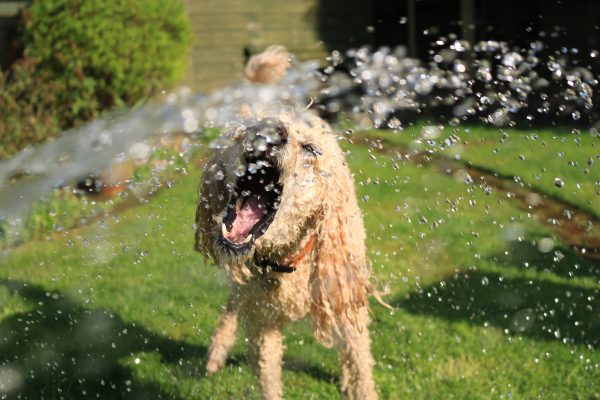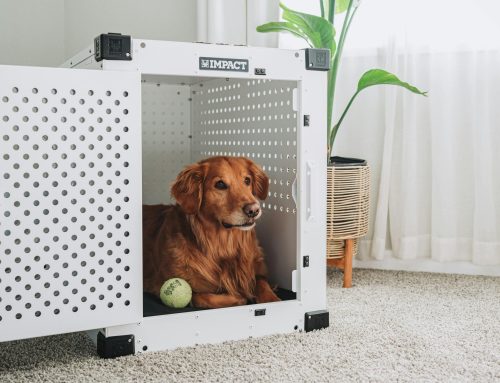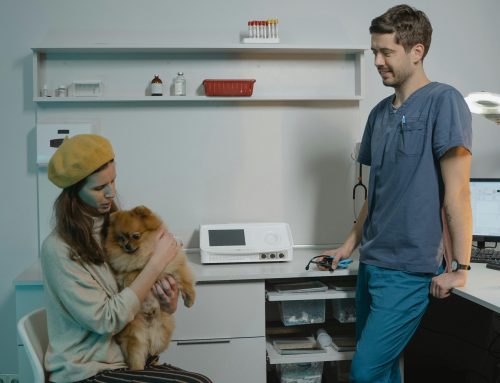
It’s that time of year again in Florida…when stepping outside feels like you have taken a blow dryer to the face. The rest of the world calls this time of year summer! While we’re dealing with frizzy humidity-ridden hair and making sure we’re wearing sunscreen, our furry friends are facing a few of their own summertime dilemmas.
HOW DO YOU KNOW WHEN HOT IS TOO HOT?
Remember that time at the beach when you were ready to head back to the car, but your flip flops were at the very bottom of your beach bag? You think you can make it across the hot pavement to your car fast enough before your feet burn but…Ouch! The surfaces of pavement, asphalt, wood and even sand can become extremely hot very quickly during the summer months. The temperatures of these surfaces can get up to 145 degrees!
A good rule of thumb to gauge how a hot surface is by putting the back of your hand to it. If you’re unable to hold it there for more than 5 seconds…it’s too hot for your dog to be walking on! Prolonged exposure to hot surfaces can wreak havoc on your dog’s paw pads. While the paw pads have relatively thick tissue, they can still be subject to burns. This can be very painful, and might result in multiple weeks of pain medications and bandage changes with your veterinarian. Unfortunately, every summer our veterinarians see cases of burnt paw pads.
Making note of the time of day you’re attempting to take your pup out for a walk is also important. It takes a while for asphalt to cool down, and this only happens when the sun is no longer out. Waiting until early to late evening to take your daily walk can prevent any damage to your dog’s paws. The ideal time to walk your dog in summer might be morning, after the asphalt has had a long night without any direct sun to cool down.

HEAT STROKE – WHAT IS IT?
We all know that dogs pant to cool down, but what happens when panting is not enough to help regulate their body temperature? While dogs and cats do produce small amounts of sweat on certain parts of their body, it is not considered enough to help in the cooling process. Long periods of heat exposure can result in hyperthermia (very high body core temperature) and dysfunction of the central nervous system (such as seizures) – this condition is called heat stroke.
Normal body temperature for dogs range between 99.5-102.5 F. Hyperthermic temperatures over 103 F can be enough for dangerous processes to begin in the body. Once the body temperature reaches over 106 F, your pet is in the danger zone! At this point the body is entering heat stroke, where multiple organs can begin to shut down.
Being able to identify the first signs of heat exhaustion is key! One of the first symptoms owners will notice is excessive panting. In addition to this, you might notice:
- Difficulty breathing
- Lack of response to your call
- Increased heart rate
- Bright red gums
In advanced cases, some owners might notice bloody diarrhea, vomiting, seizures and even collapse. If your dog is showing any of these signs, it is best to get him in the car immediately and call your veterinarian while you’re on the way there. This allows for your veterinary team to prepare for your pet’s urgent arrival.
Some dogs can be more prone to heat exhaustion and heat stroke from birth. These dogs are referred to as “brachycephalic” breeds (AKA- the smooshed-face pups). Breeds in this category can include English Bulldogs, French Bulldogs, Boston Terriers and Boxers. These dogs are less effective at panting due to the anatomy of their short faces, so moving air back and forth can sometimes be a struggle on a normal day-to-day basis. When you add in the high outside temperatures and the intense need to cool their own body temperature down, panting almost becomes ineffective during heat stroke.
While heat stress is not as common in cats, it can occur. Cats rarely pant, so if you see your cat open mouth breathing it is probably a sign of trouble. The other signs of heat stress in cats are similar to dogs, but tend to be harder to notice. Unfortunately, our feline patients like to hide their discomfort from us and sometimes that delays much needed treatment.

SUMMER FUN WITHOUT THE SUN
So you might be thinking…how can my dog and I enjoy the summer without worrying about the dangers of heat? There are several measures you can take to ensure your dog is as cool as a cucumber outside:
- Avoid long periods of sun exposure – instead of hanging out directly in the sun, try to find areas of shade where it’s cooler.
- Provide plenty of water – keeping fresh water available allows your dog to let himself cool himself down as needed.
- Utilize water activities – taking your dog for a swim is a great way to burn off some energy while still staying cool. No pool? Try letting your dog run through the sprinklers or even chase him with a hose! Some dogs find this activity much more engaging than just swimming.
- Go for walks in the early morning or late evening – this reduces the risk of sun and heat related mishaps due to lower temperatures.
Bonus tip! Never leave your dog (or literally any living, breathing creature) in an unattended vehicle. Even if the car is in the shade and you have the windows rolled down or cracked, internal car temperatures can reach up to 120 F in minutes!
How can we help?
If think your pet is suffering from heat stroke, or would like to learn more about what you can do to avoid this life-threatening situation, the vets and staff at West Park Animal Hospital are here to help. As always, the veterinarians at West Park Animal Hospital want you to feel comfortable with the care your pet is getting. We’ve designed all of our appointments to provide ample time to discuss all of your concerns and answer your questions. What is most important to us is that we provide your pet with the highest level of care by creating an individual plan for each of our patients. If you’d like to discuss more about your pet’s needs, call us at (813) 749-6863 for an appointment or conveniently schedule one on our website.






Leave A Comment